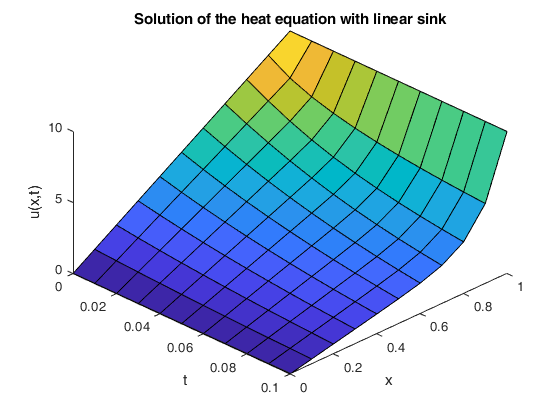Solving heat equation using finite differences
Math 613 o Fall 2019 o Victor Matveev o Homework 6 o Problem 3
clear; N = 10; % Number of space partitions M = 10; % Number of time partitions / steps gamma = 10; % Model parameters (feel free to change) Length = 1; % Length of the cable / rod / tube D = 0.2; % Diffusion coefficient dt = 0.01; % Delta t dx = Length / N; % Delta x u0 = @(x) 10*x; % Initial condition, defined as an in-line function uLeft = u0(0); % Boundary condition on the left = u0(0) = 0 uRight = u0(Length); % Boundary condition on the right = u0(L) = L = 10 s = D*dt/dx^2; % Stencil parameter s p = gamma*dt; % Stencil parameter p k = 1 - 2*s - p; % Central stencil parameter k = 1 - 2s - p % %%%%%%%%% First, construct and initialize the solution array: %%%%%%%%%%% u = zeros(N+1, M+1); % Create solution array variable u( 1, :) = uLeft; % Boundary condition on the left (indexing starts at 1 in MATLAB) u(N+1, :) = uRight; % Boundary condition on the right xArray = dx*(0:N); % Array of x-values (for the plot and IC calculation) tArray = dt*(0:M); % Array of t-values (for the plot) for n = 2 : N u(n, 1) = u0(xArray(n)); % Compute initial condition (see above) end % %%%%%%%%%%%%%%%%%%%%% Now, solve the PDE (easy!!) %%%%%%%%%%%%%%%%%%%%%% for m = 1 : M for n = 2 : N u(n, m+1) = s*(u(n-1, m) + u(n+1, m)) + k*u(n, m); end end % %%%%%%%%%%%%%%%%%%% Finally, plot the results: %%%%%%%%%%%%%%%%%%%%%%%% [X, T] = meshgrid(xArray, tArray); figure; hold on; surf(T, X, u'); view(45, 45); xlabel('t'); ylabel('x'); zlabel('u(x,t)'); title('Solution of the heat equation with linear sink');
